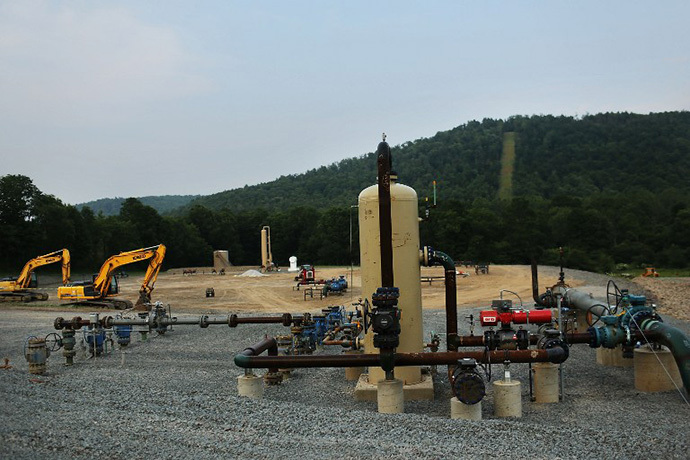Nuclear implications of Fracking
The metal which was formerly employed for the shaped charge head or “gun” was copper. This creates a pressure of 300,000 atmospheres which pushes the rock aside by plastic deformation. But in 1984 aUS patent (US 4441428) was filed by one Thomas Wilson, entitled “Conical Shaped Charge Liner of Depleted Uranium.” The patent begins: “this invention relates to a novel blasting device especially adapted for drilling oil and gas wells.” Wilson records that DU is 5-times as efficient as copper in terms of the length of the jetted hole, creating a pressure of 600,000 atmospheres. Because of the uranium’s greater chemical reactivity it actually creates new chemical compounds with the material in the rock (and the oil and gas).
The DU cuts through the rock like butter, just as the military versions of this technology, which we believe has been fitted to missiles can cut through concrete reinforced bunkers. The multiple-shaped charge explosions will certainly shake the ground. The earth tremors and earthquakes are then not so hard to explain. Where do the process water acids, chemical compounds end up? At the surface? In the local aquifer? In the local rivers? Yes. But where to the DU nanoparticles from the shaped charge end up? Perhaps the mix of process water and chemicals spilled at the surface. Perhaps in the oil or in the gas. In your kitchen? No one looks, but someone should, since we know from the Iraq wars what these things can do to human health.
In case you might think this is all scaremongering, academic and unrelated to fracking, another patent was filed more recently in 2011 (US Patent 20110000669) by Halliburton (think: oil, gas, armaments, missiles, Dick Cheney) entitled “Perforating gun assembly and method for controlling wellbore pressure during perforating”. The patent specifically refers to Depleted Uranium.
So not only is there a lot of natural radioactive material surfacing in the gas or oil stream, and the production water, there is the possibility also a lot of unnatural radioactivity coming up from the DU shaped charges. And besides the fact that Depleted Uranium is the most efficient of these shaped charge metals, let’s not forget the attraction to the US nuclear industry of a way of getting rid of its vast stocks of Depleted Uranium, or even natural Uranium, or even nuclear waste. I mean, who is going to look at the radioactivity in the process water? It will be radioactive from the Radium and Radon daughters anyway. You would need to carry out some sophisticated analysis to see if it contained any nasty man-made radionuclides, especially DU nanoparticles. Who will do that?
Fracking contamination
The issue of natural radioactivity and fracking gas was raised by my friend, Marvin Resnikoff, who was an expert on the NORM cases. He has examined the fracking situation in relation to the exploitation of the Marcellus Shale gas, New York State. He pointed out that there were two critical issues. There is the concentration of Radium-226 in the rock. Then there is the length of time it takes for the gas to get to the kitchen.
Radon has a half-life of about four days, and so if the gas takes a short time to get from the well production site to the consumer, then levels in the kitchen can be significant. He calculated that there would be between 1,000 and 30,000 extra lung cancers in New York State from such an exposure. And that no one in environmental protection agencies had paid any attention to this issue.
This is certainly of concern, but there are other issues. The process water (and chemicals) certainly contaminates the areas around the gas production machinery. In a recent court case I was involved with in Louisiana there was a gas distribution plant that was scarily radioactive, and the land around it was also radioactive. I also studied oil well production areas in a Kentucky court case. The process water dissolves Radium-226 and this precipitates as scale on the pipes and tanks and is left on the ground near the wellheads and distribution facilities. The transfer pipes are radioactive. One of the worst radionuclides left behind is the Radon daughter Lead-210 which has a longish half-life (22 years) and builds up in these situations as a fine dust. It gets into the gas stream as nanoparticles and I believe it remains in the gas stream. It decays to Bismuth-210 which immediately decays to the alpha emitter Polonium-210 with a half-life of 138 days.
Fracking will increase the amount of Radon in the extracted gas. Why? Because of the high surface area created by smashing up the rock. In the simple gas or oil well there is a big cavern. The radon seeps out of the wall which has a surface area equal to that of the cavern wall. But in the case of the fracked strata, the surface area out of which the Radon can seep is enormously enhanced. So a faster Radon transfer can occur.
Burning our ship
So I conclude that fracking carries with it some serious health issues relating to radiation exposure and local contamination, issues which, as Marvin Resnikoff points out in his articles, have not been addressed properly (or at all) by the environmental impact statements published by the operators, or by the Environmental Protection Agency in the USA. The well heads and distribution areas will become radioactively contaminated. Isolated wells along the south coast of England, the Texas-ification of Sussex being encouraged by Prime Minister David Cameron, will not be like windmills. The contamination from the process water will get into the groundwater and drinking water. And let’s not forget the Depleted Uranium.
Read more at:-
http://rt.com/op-edge/fracking-radioactive-uranium-danger-ecology-057/











0 comments:
Post a Comment